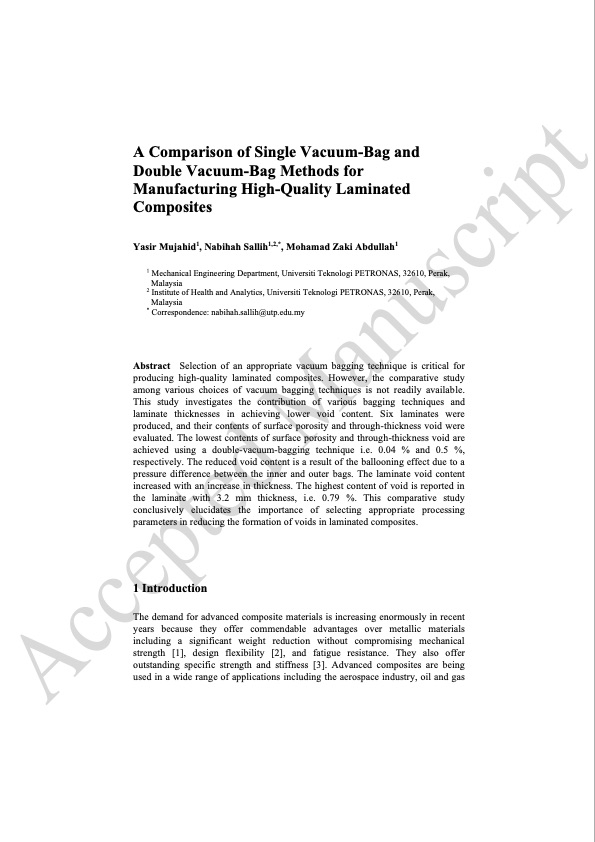
PDF Publication Title:
Text from PDF Page: 002
A Comparison of Single Vacuum-Bag and Double Vacuum-Bag Methods for Manufacturing High-Quality Laminated Composites Yasir Mujahid1, Nabihah Sallih1,2,*, Mohamad Zaki Abdullah1 1 Mechanical Engineering Department, Universiti Teknologi PETRONAS, 32610, Perak, Malaysia 2 Institute of Health and Analytics, Universiti Teknologi PETRONAS, 32610, Perak, Malaysia * Correspondence: nabihah.sallih@utp.edu.my Abstract Selection of an appropriate vacuum bagging technique is critical for producing high-quality laminated composites. However, the comparative study among various choices of vacuum bagging techniques is not readily available. This study investigates the contribution of various bagging techniques and laminate thicknesses in achieving lower void content. Six laminates were produced, and their contents of surface porosity and through-thickness void were evaluated. The lowest contents of surface porosity and through-thickness void are achieved using a double-vacuum-bagging technique i.e. 0.04 % and 0.5 %, respectively. The reduced void content is a result of the ballooning effect due to a pressure difference between the inner and outer bags. The laminate void content increased with an increase in thickness. The highest content of void is reported in the laminate with 3.2 mm thickness, i.e. 0.79 %. This comparative study conclusively elucidates the importance of selecting appropriate processing parameters in reducing the formation of voids in laminated composites. 1 Introduction The demand for advanced composite materials is increasing enormously in recent years because they offer commendable advantages over metallic materials including a significant weight reduction without compromising mechanical strength [1], design flexibility [2], and fatigue resistance. They also offer outstanding specific strength and stiffness [3]. Advanced composites are being used in a wide range of applications including the aerospace industry, oil and gasPDF Image | Comparison of Single-Vacuum-Bag and Double-Vacuum-Bag Methods

PDF Search Title:
Comparison of Single-Vacuum-Bag and Double-Vacuum-Bag MethodsOriginal File Name Searched:
1912176.pdfDIY PDF Search: Google It | Yahoo | Bing
5,000 BF Shipping Container Lumber Dry Kiln For Quality Lumber The 5,000 BF container kiln consists of one 40 foot high-cube aluminum shipping container... More Info
Shipping Container Lumber Dry Kilns by Global Energy Global Energy designed and developed the container kiln back in 1991. The purpose is to give access to portable sawmill owners, furniture makers, and small business the value added profit of dry kiln lumber and quality hardwoods... More Info
Vacuum Kiln Conversion Kit for Lumber and Wood Dry Kilns Convert your existing conventional dry kiln into a fast drying vacuum kiln. Similar to vacuum bagging in the boat building and aircraft industry, we have come up with a proprietary process which allows you to build a very simple vacuum kiln at a fraction of the price, and without the intensive conventional metal chamber structure... More Info
Vacuum Pump Cart System for Bagging Clamping Wood Drying and more Vacuum Cart with 2HP Pump and Dual Pistons with multiple multiplex vacuum ports and liquid reservoir... More Info
Vacuum Bagging Basics Vacuum bagging is a method of clamping, which has traditionally been used in the composites industry, but can also be used for vacuum drying materials, including wood products... More Info
| CONTACT TEL: 608-238-6001 Email: greg@globalmicroturbine.com | RSS | AMP |